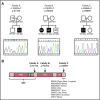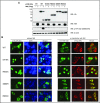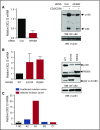Novel nonsense gain-of-function NFKB2 mutations associated with a combined immunodeficiency phenotype
- PMID: 28778864
- PMCID: PMC5620416
- DOI: 10.1182/blood-2017-05-782177
Novel nonsense gain-of-function NFKB2 mutations associated with a combined immunodeficiency phenotype
Abstract
NF-κB signaling through its NFKB1-dependent canonical and NFKB2-dependent noncanonical pathways plays distinctive roles in a diverse range of immune processes. Recently, mutations in these 2 genes have been associated with common variable immunodeficiency (CVID). While studying patients with genetically uncharacterized primary immunodeficiencies, we detected 2 novel nonsense gain-of-function (GOF) NFKB2 mutations (E418X and R635X) in 3 patients from 2 families, and a novel missense change (S866R) in another patient. Their immunophenotype was assessed by flow cytometry and protein expression; activation of canonical and noncanonical pathways was examined in peripheral blood mononuclear cells and transfected HEK293T cells through immunoblotting, immunohistochemistry, luciferase activity, real-time polymerase chain reaction, and multiplex assays. The S866R change disrupted a C-terminal NF-κΒ2 critical site affecting protein phosphorylation and nuclear translocation, resulting in CVID with adrenocorticotropic hormone deficiency, growth hormone deficiency, and mild ectodermal dysplasia as previously described. In contrast, the nonsense mutations E418X and R635X observed in 3 patients led to constitutive nuclear localization and activation of both canonical and noncanonical NF-κΒ pathways, resulting in a combined immunodeficiency (CID) without endocrine or ectodermal manifestations. These changes were also found in 2 asymptomatic relatives. Thus, these novel NFKB2 GOF mutations produce a nonfully penetrant CID phenotype through a different pathophysiologic mechanism than previously described for mutations in NFKB2.
Conflict of interest statement
Conflict-of-interest disclosure: M.P.S. is a cofounder and member of the scientific advisory board of Personalis Inc, which was used for WES of one of the patients in this work. The remaining authors declare no competing financial interests.
Figures






References
-
- Cunningham-Rundles C, Bodian C. Common variable immunodeficiency: clinical and immunological features of 248 patients. Clin Immunol. 1999;92(1):34-48. - PubMed
-
- Bogaert DJ, Dullaers M, Lambrecht BN, Vermaelen KY, De Baere E, Haerynck F. Genes associated with common variable immunodeficiency: one diagnosis to rule them all? J Med Genet. 2016;53(9):575-590. - PubMed
Publication types
MeSH terms
Substances
Supplementary concepts
LinkOut - more resources
Full Text Sources
Other Literature Sources
Miscellaneous

